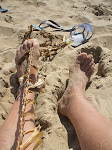 |
| Coiled Shetland oat straw basket made by Jimmy Work |
Oats were the staple grain in the Shetland Islands prior to the 20th Century and as in al l rural communities at that time their use was completely sustainable, nothing was wasted. The threshed grain used for porridge, flour and animal feed was ground by smal l water mills set in the burns. The remaining straws were then used for things such as roofing, stuffing mattresses, wrapping the feet in cold weather, mats for threshing, animal bedding and costumes for festival s. And, as in so many other rural communities al l over the world they were also used for making baskets.
 |
| Image taken from an old postcard showing large coiled straw basket |
These islands are thought to have been inhabited for at least 5000 years but there is little evidence to suggest that there was ever a strong tradition of weaving with woody plants. There used to be trees in Shetland but they disappeared a long time ago, so for centuries there were few indigenous material s for basket making, little willow or hazel, certainly no oaks, ashes or chestnuts. Consequently the baskets of these islands had to be made with the native material s that could be gleaned or grown, such as oats, dockens, bent, rushes and heather.There was no riving, skeining or plaiting of anything tree or bark like, just the softer more textile tradition of twining, and for sturdier items, coiling. No axes or woodworkers 'donkeys' were involved just hands and pocket knives and bone or driftwood needles.
The Shetland Islands have a long tradition of spinning, knitting and weaving the fine wool that the indigenous sheep provide. This was the job of the women; basket making was the domain of the men and was an activity for the winter when the weather and short days forced them indoors.
The oats that grew here in the 19th and 20th Century here were different. They were fine and stayed green and softer for longer making them ideal for basket making unlike the nitrogen-fuelled cereals of today, bruisers by comparison, short, muscular, and brittle. Now there are few people who grow these oats and those that do provide special ist needs such as val ue added local oatcakes, the roofing of a few listed buildings and the last semi-professional basket-maker Jimmy Work who only uses Shetland oats.
The oats that grew here in the 19th and 20th Century here were different. They were fine and stayed green and softer for longer making them ideal for basket making unlike the nitrogen-fuelled cereals of today, bruisers by comparison, short, muscular, and brittle. Now there are few people who grow these oats and those that do provide speci
 |
| Jimmy Work in his 'real' indoor work place |
 |
| Jimmy and selection of his baskets in a 'staged' work place made for a 1998 Calendar . Photograph by Bill Jackson for The Shetland Times. |
Jimmy started making baskets in 1958 and he hasn't stopped. He says he taught himself and today at 88 he still makes the fine simple elegant coiled baskets that have become his trade mark. These are not tradition
Jimmy has made hundreds of them, he doesn't know how many, and they have been sent to
 |
Jimmy says he can al ways recognise his baskets because he makes them without adding extra lines of stitching on the sides. There is the same number of stitches at the edge of the base as at the top edge regardless of any outward flow of the form. They are beautifully crafted, sturdy, functional and elegant baskets. He has never had any desire to al ter his technique or his material s and it is probably because he has al ways made them the same way that they are so good.
 |
| Base of the basket |
I asked Jimmy if he had ever taught anyone else to make them. I had heard whispers on the wind that he had refused to teach a woman who had offered to pay him for tuition. Apparently he told her that a woman would never have the strength to do it. I didn’t ask him if it was true, nor did I dare tell him I make baskets but I am very glad to hear that he is now passing on his precious knowledge to a couple of people – both mal e!










